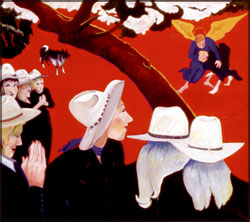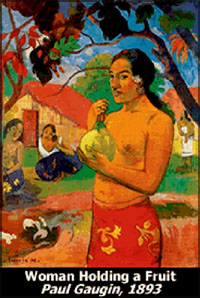Driven by the mystery of tropical paradise
* For Europeans the
romantic
strangeness and eroticism of his
paintings of the islanders, the festivities with their unknown
symbolism, are
inherently attractive, and this has
tended to obscure Gauguin's real contribution. The quality of his art
does not reside
in revelations of another
culture but in the aesthetic position he arrived at. (Trewin Copplestone)
* Portentous allegories about the
destiny of mankind. (John Russell)
EugSne Henri
Paul Gauguin (June 7, 1848 - May 9, 1903) was a leading
Post-Impressionist artist. Best known as a painter, his bold
experimentation with coloring led directly to the Synthetist style of
modern art while his expression of the inherent meaning of the subjects
in his paintings, under the influence of the cloisonnist style, paved
the way to Primitivism and the return to the pastoral. He was also an
influential exponent of wood engraving and woodcuts as art forms.
Paul Gauguin was born in Paris, France to journalist Clovis Gauguin
and half-peruvian Aline Maria Chazal, the daughter of a socialist leader. In 1851 the family left Paris for Peru
motivated by the political climate of the period. Clovis died on the
voyage, leaving three-year old Paul, his mother and his sister to fend
for themselves. They lived for four years in Lima, Peru with Paul's
uncle and his family. The imagery of Peru would later influence Paul in
his art.
daughter of a socialist leader. In 1851 the family left Paris for Peru
motivated by the political climate of the period. Clovis died on the
voyage, leaving three-year old Paul, his mother and his sister to fend
for themselves. They lived for four years in Lima, Peru with Paul's
uncle and his family. The imagery of Peru would later influence Paul in
his art.
At the age of seven, Paul and his family returned to France. They
moved to Orleans, France to live with his grandfather.
He soon learned French and excelled in his studies. At seventeen,
Gauguin signed on as a pilot's assistant in the merchant marine to
fulfill his required military service. Three years later, he joined the
navy where he stayed for two years. In 1871, Gauguin returned to Paris
where he secured a job as a stockbroker. In 1873, he married a Danish
woman Mette Sophie Gad. Over the next ten years, they would have five
children.
Gauguin had been interested in art since his childhood. In his free
time, he began painting. He would also frequent galleries and purchase
many of the new art coming out in Paris. Gauguin formed a friendship
with artist Camille Pissarro, who introduced him to various artists
through his connections.
As he progressed in his art, Gauguin rented a studio, and showed
paintings in impressionist exhibitions held in 1881 and 1882. Over two
summer vacations, he painted with Pissarro and occasionally Paul C,zanne.
By 1884 Gauguin had moved with his family to Copenhagen, where he
unsuccessfully pursued a business career. Driven to paint full-time, he
returned to Paris in 1885, leaving his family in Denmark. Without
adequate subsistence, his wife (Mette Sophie Gadd) and their five
children returned to her family. Gauguin outlived two of his children.
 Like
his friend Vincent Van Gogh, with whom he spent nine weeks painting in
Arles, Paul Gauguin experienced bouts of depression and at one time
attempted suicide. Disappointed with Impressionism, he felt that
traditional European painting had become too imitative and lacked
symbolic depth. By contrast, the art of Africa and Asia seemed to him
full of mystic symbolism and vigour. There was a vogue in Europe at the
time for the art of other cultures, especially that of Japan (Japonisme).
He was invited to participate in the 1889 exhibition organized by Les
XX. Like
his friend Vincent Van Gogh, with whom he spent nine weeks painting in
Arles, Paul Gauguin experienced bouts of depression and at one time
attempted suicide. Disappointed with Impressionism, he felt that
traditional European painting had become too imitative and lacked
symbolic depth. By contrast, the art of Africa and Asia seemed to him
full of mystic symbolism and vigour. There was a vogue in Europe at the
time for the art of other cultures, especially that of Japan (Japonisme).
He was invited to participate in the 1889 exhibition organized by Les
XX.
Under the influence of folk art and Japanese prints, Gauguin evolved
towards Cloisonnism, a style given its name by the critic ?douard
Dujardin in response to Emile Bernard's cloisonne enamelling technique.
Gauguin was very appreciative of Bernard's art and of his daring with
the employment of a style which suited Gauguin in his quest to express
the essence of the objects in his art.
In The Yellow Christ (1889), often cited as a quintessential
Cloisonnist work, the image was reduced to areas of pure colour
separated by heavy black outlines. In such works Gauguin paid little
attention to classical perspective and boldly eliminated subtle
gradations of colour-thus dispensing with the two most characteristic
principles of post-Renaissance painting.
His painting later evolved towards "Synthetism" in which neither form
nor colour predominate but each has an equal role.
In 1891, Gauguin, frustrated by lack of recognition at home and
financially destitute, sailed to the tropics to escape European
civilization and "everything that is artificial and conventional."
(Before this he had made several attempts to find a tropical paradise
where he could 'live on fish and fruit' and paint in his increasingly
primitive style, including short stays in Martinique and as a worker on
the Panama Canal).
Living in Mataiea Village in Tahiti, he painted "Fatata te Miti" ("By
the Sea"), "La Orana Maria" (Ave Maria) and other depictions of Tahitian
life. He moved to Punaauia in 1897, where he created the masterpiece
painting "Where Do We Come From" and then lived the rest of his life in
the Marquesas Islands, returning to France only once.
His works of that period are full of quasi-religious symbolism and an
exoticized view of the inhabitants of Polynesia.
In Polynesia he clashed often with the colonial authorities and with
the Catholic Church. During this period he also wrote the book Avant et
AprSs (before and after), that is a fragmented collection of
observations about life in Polynesia, memories from his life and
comments on literature and paintings.
In 1903 due to a problem with the church and the government he was
sentenced to three months in prison, and he owed a fine. At that time he
was being supported by an art dealer. He died of syphilis before he
could start the prison sentence. His body had been weakened by
alcoholism and a dissipated life style. He was 54 years old. |
